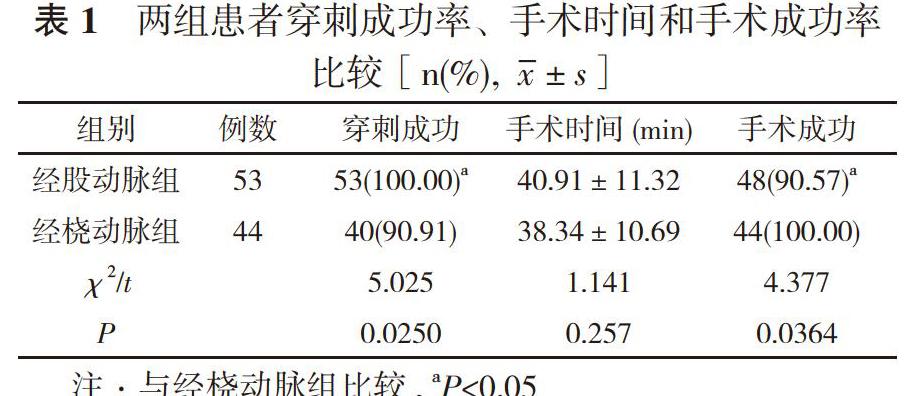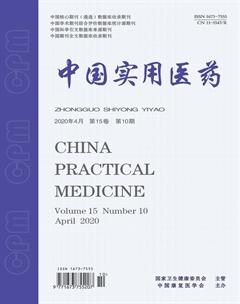经股动脉入路和经桡动脉入路行全脑血管造影术的应用效果观察
孔杰 占大权


【摘要】 目的 觀察经股动脉入路和经桡动脉入路行全脑血管造影术的优缺点和并发症发生情况。方法 97例行全脑血管造影术的患者, 根据手术路径的不同分为经股动脉组(53例)和经桡动脉组(44例)。经股动脉组采用经股动脉入路行全脑血管造影术, 经桡动脉组采用经桡动脉入路行全脑血管造影术。观察比较两组患者穿刺成功率、手术时间、手术成功率、术后并发症(栓塞事件、穿刺处大血肿、假性动脉瘤、尿潴留)发生情况。结果 经股动脉组穿刺成功率100.00%高于经桡动脉组的90.91%, 差异具有统计学意义(P<0.05)。两组手术时间比较, 差异无统计学意义(P>0.05)。经桡动脉组手术成功率100.00%高于经股动脉组的90.57%, 差异有统计学意义(P<0.05)。经桡动脉组并发症发生率4.55%低于经股动脉组的18.87%, 差异有统计学意义(P<0.05)。结论 两种手术路径均能很好地完成全脑血管造影术, 经股动脉入路穿刺难度较低, 易于掌握, 但并发症较多。经桡动脉入路并发症较少, 但穿刺成功率较低, 对术者要求较高。
【关键词】 全脑血管造影术;经股动脉入路;经桡动脉入路
DOI:10.14163/j.cnki.11-5547/r.2020.10.009
【Abstract】 Objective To observe the advantages, disadvantages and occurrence of complications of the whole brain angiography through the femoral artery approach and the radial artery approach. Methods A total of 97 patients with total cerebral angiography were divided into femoral artery approach group (53 cases) and radial artery approach (44 cases) by different operative approaches. Femoral artery approach group received total cerebral angiography through femoral artery approach, and radial artery approach group received total cerebral angiography through radial artery approach. The success rate of puncture, operation time, surgical success rate, occurrence of postoperative complications (embolism event, large hematoma at the puncture site, pseudoaneurysm, urinary retention) between the two groups were observed and compared. Results The success rate of puncture 100.00% in femoral artery approach group was higher than 90.91% in radial artery approach group, and the difference was statistically significant (P<0.05). There was no statistically significant difference in operation time between the two groups (P>0.05). The operative success rate 100.00% in radial artery approach group was higher than 90.57% in femoral artery approach group, and the difference was statistically significant (P<0.05). The incidence of complications 4.55% in radial artery approach group was lower than 18.87% in femoral artery approach group, and the difference was statistically significant (P<0.05). Conclusion Both operative approaches can complete the whole cerebral angiography well. The femoral artery puncture is relatively difficult and easy to master, but there are many complications. The radial artery approach has fewer complications, but the success rate of puncture is lower, and the requirements for the operator are higher.
【Key words】 Total cerebral angiography; Femoral artery approach; Radial artery approach
[3] Campeau L. Percutaneous radial approach for coronary angiography. Cathet Cardiovasc Diagn, 1989, 16(1):3-7
[4] Novara AM, Kallmes DF. Transradial cerebral angiography: technique and outcomes. Am J Neuroradiol, 2003, 24(6):1247-1250.
[5] Moran CJ, Milburn JM, Cross DT, et al. Randomized controlled trial of sheaths in diagnostic neuroangiography. Radiology, 2001, 218(1):183-187.
[6] Kiryosue H, Okahara M, Nagatomi H, et al. 3.3F catheter/sheath system for use in diagnostic neuroangiography. Am J Neuroradiol, 2002, 23(4):711-715.
[7] 趙美英, 王润青, 刘威, 等. 缺血性脑血管病脑血管造影及介入治疗术后并发症的分析与处理. 中国实用神经疾病杂志, 2015, 12(5):85-86.
[8] 李卫东. 缺血性脑血管病介入诊断和治疗的临床研究. 中西医结合心血管病电子杂志, 2015, 16(3):77-78.
[9] 艾克拜尔·加马力, 关玉华. 经桡动脉与经股动脉途径全脑血管造影的对比分析. 临床医药文献电子杂志, 2018, 5(10):130-131.
[10] 廖耿, 薛华杰, 黄婉芸, 等. 经桡动脉与经股动脉途径行选择性全脑血管造影的对比研究. 中国医药科学, 2012, 2(21):19-20.
[11] 苏江利, 亓立峰, 曲怀谦. 经桡动脉途径行全脑血管造影的可行性与安全性研究. 中华解剖与临床杂志, 2014(4):294-298.
[12] 黄永军, 安红伟, 鹿俊磊, 等. 经桡动脉和经股动脉途径行全脑血管造影临床对比分析. 山西医药杂志, 2013, 42(3):298-300.
[收稿日期:2019-08-14]

